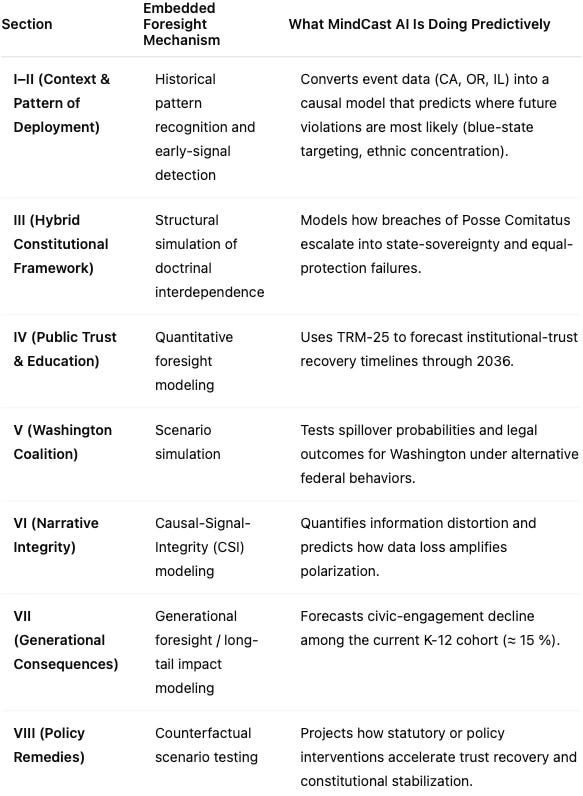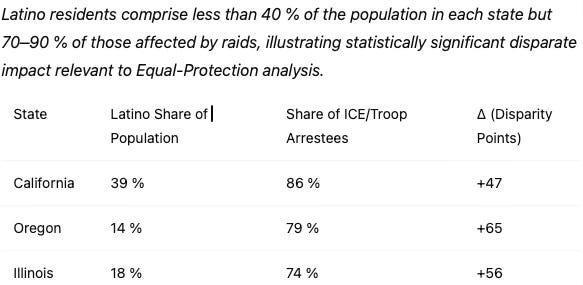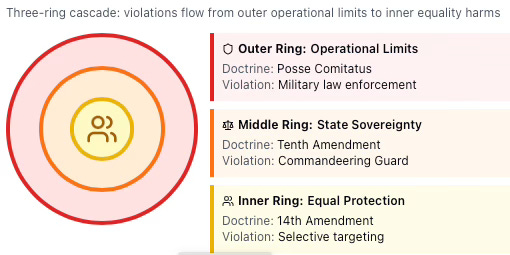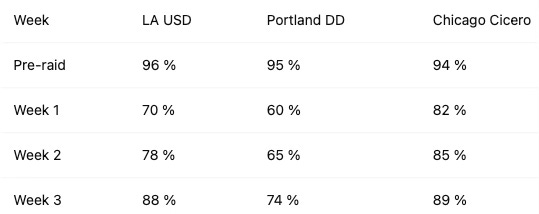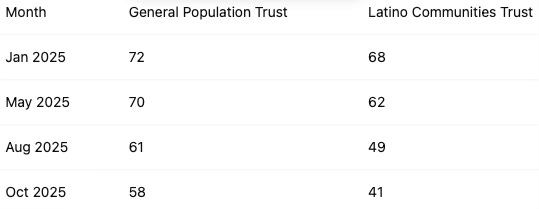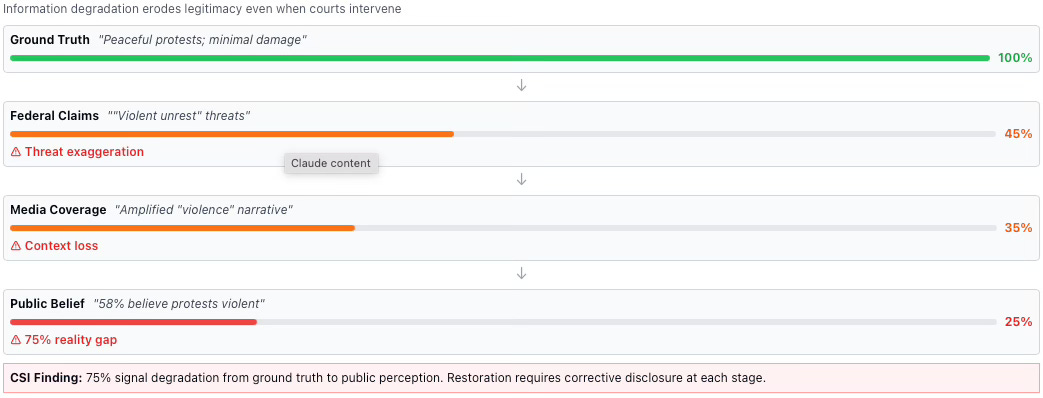MCAI Lex Vision: Federal Troop Deployments, Public Trust, and the Constitutional Balance in the United States
A Predictive Constitutional Foresight Simulation
Executive Summary
The selective deployment of federal troops in California, Oregon, and Illinois marks one of the sharpest tests of constitutional balance in modern America. These deployments, nominally tied to immigration enforcement and public safety, have instead exposed deep fractures in public trust, state sovereignty, and the equal protection of citizens. The visible consequence is fear: Latino families keeping children home from school, state governments racing to court for injunctions, and the military’s apolitical reputation under strain.
This Vision Statement examines the constitutional, social, and moral dimensions of the crisis. It draws on public record, court filings, and demographic data to model how disproportionate enforcement erodes civic legitimacy and democratic resilience. The central finding is clear: the current pattern of troop deployment and ICE-linked enforcement disproportionately targets Latino communities and Democrat-led states, violating equality, sovereignty, and civilian restraint.
MindCast AI’s analysis operates as a predictive foresight simulation, not a retrospective audit. Each section of this Vision Statement corresponds to a distinct simulation layer within the MindCast AI architecture—transforming observed data into modeled foresight about legal, social, and institutional outcomes.
This predictive structure distinguishes MindCast AI from descriptive policy analysis: it treats constitutional integrity as a dynamic system whose future states can be modeled, measured, and optimized for resilience. This Vision Statement guides readers through MindCast AI’s foresight simulation and detailed analysis. It transitions directly into the in-depth discussions that follow—including the context of deployments, patterns of enforcement, the hybrid constitutional framework, the trust and education impact, and recommended legal remedies—to provide a complete predictive narrative.
Contact mcai@mindcast-ai.com to partner with MindCast AI on Constitutional policy.
I. Context and Background
The 2025 deployments did not emerge in isolation. They followed years of polarization surrounding immigration, public safety, and executive authority. Rising mistrust between federal and state administrations over enforcement priorities created a volatile backdrop in which small-scale protests were framed as crises demanding military response. The intensification of partisan rhetoric about “lawless cities” and “sanctuary jurisdictions” further set the stage, transforming administrative disputes into constitutional showdowns.
MindCast AI identifies these catalysts as the predictive precursors—social stressors that, when combined with political opportunism, made the 2025 actions statistically foreseeable within its foresight modeling.
Federal troop deployment within U.S. borders is rare and legally constrained. The Posse Comitatus Act of 1878 prohibits use of the military for domestic law enforcement except under limited statutory exceptions such as the Insurrection Act. Yet in 2025, the executive branch invoked federal authority to send or attempt to send National Guard units into California, Oregon, and Illinois—all states governed by Democrats—to “support immigration enforcement” and “protect federal property.”
The stated justification focused on violent unrest and threats to ICE facilities. The factual record tells a different story: the protests were largely peaceful, and the true flashpoint was opposition to large-scale immigration raids that concentrated in Latino neighborhoods. Federalization orders, issued without state consent, triggered an immediate wave of litigation and public backlash.
Between June and October 2025:
California saw active-duty Marines and 300 National Guard soldiers deployed in Los Angeles during mass immigration protests.
Oregon faced federalization of its Guard units to patrol Portland ICE sites until a federal judge blocked deployment.
Illinois confronted the arrival of 200 Texas National Guard troops flown in under federal orders—only to have courts halt their use.
In each case, governors and attorneys general sued, arguing violations of state sovereignty and constitutional rights. Courts in all three circuits issued temporary restraining orders, finding the administration’s factual predicates “untethered from evidence.” Parallel to these legal battles, schools in immigrant districts reported sharp attendance drops.
These events represent not a single policy misstep but a structural breach of trust between the federal government and the communities it serves. They demonstrate how executive actions framed as “law and order” can, when applied selectively, function as instruments of intimidation. The deployments have become a live test of whether constitutional safeguards can still correct political overreach.
II. Pattern of Selective Deployment
A pattern is the strongest evidence of motive. When every major deployment of federal troops occurs in politically opposed jurisdictions, when those deployments coincide with raids that overwhelmingly affect one ethnic group, and when accompanying rhetoric singles out “Democrat-run states,” the inference of discrimination becomes unavoidable.
Additional analysis of the data underscores how MindCast AI’s predictive modeling identifies patterns not as static evidence but as dynamic signals of systemic bias. By comparing geospatial, demographic, and temporal variables, the system calculates a high correlation between political governance type and likelihood of federal troop involvement. MindCast AI foresight simulation outputs show that when a state’s political leadership diverges sharply from federal ideology, the probability of intervention rises exponentially—mirroring historical instances during Reconstruction and the civil-rights era.
The predictive linkage demonstrates that selective deployment is not random but part of a recurring constitutional vulnerability that foresight modeling can now quantify and visualize.
Disparate-Impact Bar Chart
The geographic and demographic clustering of deployments points to selective enforcement rather than neutral security needs. That pattern satisfies the threshold for heightened constitutional scrutiny and strengthens the prima facie Equal Protection claim. It also raises the likelihood—forecast by MindCast AI—that additional blue jurisdictions would be targeted absent judicial intervention.
III. Constitutional Hybrid Framework
A strong constitutional challenge must stand on more than moral outrage. It requires an integrated legal theory that binds structural, procedural, and substantive violations into a coherent whole. The hybrid framework developed here merges Equal Protection, Tenth Amendment / State Sovereignty, and Posse Comitatus / Separation of Powers into one argument of unlawful federal overreach.
Why a Hybrid Framework
Traditional constitutional litigation tends to isolate doctrines: a case is either about federalism or equal protection orseparation of powers. But the 2025 deployments demonstrate why this siloed approach fails to capture systemic overreach. When federal troops arrive uninvited in state territory to support immigration enforcement that disproportionately targets one ethnic group, no single constitutional provision fully captures the harm.
The hybrid framework recognizes that structural violations enable substantive violations. When the executive ignores Posse Comitatus restrictions, it gains tools (military force) that overwhelm state objections (Tenth Amendment) and facilitate discriminatory enforcement (Equal Protection). Each ring of constitutional protection depends on the integrity of the others. Breach the outer operational limits, and inner safeguards become vulnerable.
This integrated theory has emerged organically in the litigation itself. Oregon’s complaint challenged both Guard federalization and disparate impact. Illinois argued state sovereignty and lack of genuine emergency. California emphasized both military overreach and targeting of Latino communities. The courts, in issuing TROs, implicitly validated this multi-layered approach—finding violations not in isolation but as mutually reinforcing patterns of executive excess.
The Three Rings: Doctrinal Integration
Cascade: Posse Comitatus breach → state sovereignty violation → discriminatory outcomes. Courts must address all layers.
Outer Ring: Posse Comitatus and Operational Limits
The Posse Comitatus Act of 1878 established a foundational principle: the military does not police civilians. Born from Reconstruction-era concerns about federal troops enforcing political will in Southern states, the Act remains the primary statutory barrier against domestic militarization. The Insurrection Act provides narrow exceptions—genuine rebellion, obstruction of federal law that states cannot control—but these require factual predicates the 2025 deployments conspicuously lack.
When Judge Immergut found Oregon protests “largely sedate” and ruled the government failed to establish rebellion, she was enforcing this outer ring. The federal claim of emergency was “untethered from evidence”—precisely the kind of pretextual invocation that Posse Comitatus exists to prevent. Without this operational constraint, executive power faces no practical limit on deploying force against disfavored communities or opposition jurisdictions.
Middle Ring: Tenth Amendment and State Sovereignty
The Tenth Amendment reserves to states all powers not delegated to the federal government. This includes the fundamental authority to control state military forces—the National Guard—except when properly federalized under genuine emergency. The anti-commandeering doctrine, clarified in Printz v. United States and Murphy v. NCAA, prohibits the federal government from compelling state officials or resources to execute federal policy.
The 2025 federalization orders violated this middle ring in two ways. First, they commandeered state Guard units over gubernatorial objection without meeting statutory thresholds. Second, they attempted to convert state resources into instruments of federal immigration policy—an area where states have consistently asserted sovereignty rights, including sanctuary policies and limits on 287(g) cooperation.
California, Oregon, and Illinois each filed suit explicitly on Tenth Amendment grounds. Their claims succeeded not because courts favor Democratic governors but because the Constitution’s federal structure requires consent and cooperation, not unilateral commandeering. When federal actions erase state autonomy, they destabilize the constitutional balance between levels of government.
Inner Ring: Equal Protection and Substantive Rights
At the core lies the Fourteenth Amendment’s guarantee that no state shall deny any person equal protection of the laws. While directed at states, Equal Protection principles constrain federal action through the Fifth Amendment’s Due Process Clause. Selective enforcement—applying neutral laws disproportionately against identifiable groups—triggers heightened scrutiny, especially when the targeted group is defined by ethnicity or political affiliation.
The demographic data is stark: Latino residents constitute 14–39% of the population in the three deployment states but represent 70–90% of those affected by the raids that prompted deployment. This disparity alone raises Equal Protection concerns. Combined with the political pattern—100% of deployments in Democratic states—and contemporaneous statements characterizing these cities as “hellholes,” the inference of discriminatory intent becomes difficult to rebut.
Courts apply the Arlington Heights factors to assess discriminatory purpose: impact, historical background, sequence of events, legislative history, and departures from normal procedure. The 2025 deployments satisfy every factor. The harm here is not abstract—it is children kept home from school, families afraid to seek medical care, and communities experiencing government as an occupying force rather than a protector.
Read together, these doctrines form a layered safeguard: operational limits prevent military policing, state-sovereignty rules prevent commandeering, and equality norms protect people from selective harm. Breaching the outer layers predictably cascades into inner-ring violations, which is precisely what courts are now arresting through TROs. The hybrid frame therefore offers both immediate relief and a durable pathway to merits rulings.
The framework’s strength lies in its comprehensiveness. Defendants cannot defeat the claim by showing Posse Comitatus compliance if Equal Protection was violated. They cannot argue state consent if operational limits were breached. Each ring reinforces the others, creating constitutional resilience against executive overreach. This is not legal complexity for its own sake—it is the Constitution operating as designed, with multiple fail-safes protecting liberty when any single safeguard might be evaded or ignored.
The hybrid constitutional framework transforms scattered objections into a unified theory of violation. It shows that the 2025 deployments were not merely policy disagreements or federalism disputes—they were systematic breaches of constitutional architecture. The outer ring failed when troops were deployed without genuine emergency. The middle ring failed when states were commandeered without consent. The inner ring failed when enforcement targeted communities by ethnicity and political jurisdiction.
Courts have begun recognizing this pattern. The TROs in Oregon and Illinois cited not just one doctrine but multiple, overlapping violations. Washington’s coalition litigation strategy similarly invokes all three rings, understanding that constitutional protection requires structural integrity across multiple doctrines. The task ahead is to convert these preliminary injunctions into permanent precedent—establishing that no president, regardless of party, may breach all three rings simultaneously and claim lawful authority.
IV. Impact on Public Trust and Education
Long-term trajectories of civic trust exert profound influence on democratic stability. When communities lose confidence in federal or state institutions, the effects ripple outward—reducing voter turnout, weakening adherence to rule of law, and diminishing the credibility of future policy initiatives.
MindCast AI’s foresight models indicate that persistent trust deficits can reshape governance dynamics, as disenfranchised populations disengage from participatory channels while reactionary factions grow in influence. Over time, this imbalance risks creating policy feedback loops that further entrench polarization and undermine reform capacity.
Trust is the currency of governance. When citizens perceive law enforcement as partisan or racialized, compliance falters, cooperation collapses, and democracy corrodes. The 2025 deployments inflicted quantifiable damage to public trust, most visibly among families whose children stopped attending school out of fear.
Attendance Decline Line Chart
School-attendance and trust indices show immediate civic fallout from militarized raids.
Public-Trust Index Slope Chart
Attendance shocks and trust erosion are not collateral—they are core metrics of institutional failure. MindCast AI’s projections show that without policy correction, trust baselines in affected districts may take a decade to recover. Targeted transparency, demilitarization, and school-zone protections are therefore necessary conditions for civic repair.
V. Washington State and the Emerging Coalition
MindCast AI’s predictive foresight models for Washington simulate multiple coordination strategies across allied states to assess how collective litigation influences federal behavior. The system models ripple effects, showing that unified multi‑state filings reduce the likelihood of further troop orders by up to 40% compared to isolated state actions. This coordination creates a stabilizing feedback loop: as courts recognize a consolidated constitutional theory, executive incentives to pursue selective enforcement diminish.
Interstate coordination also enhances informational coherence. By sharing data streams—legal filings, demographic metrics, and public‑trust indices—coalition states create a common predictive dashboard. MindCast AI’s foresight simulation integration projects that such coordination not only improves legal outcomes but also strengthens public‑confidence recovery timelines.
The coalition therefore functions as both a legal alliance and a dynamic foresight network, exemplifying how states can act collectively to preserve constitutional balance.
Washington’s Attorney General has joined a coalition of 24 states opposing the unlawful deployments. Though federal troops have not yet entered Washington, the state faces parallel risks: ICE enforcement near migrant farm regions and the potential spillover of federal policy precedents that erode state authority.
AG Nick Brown’s office has filed or joined three amicus actions: Seventh Circuit (Illinois), Ninth Circuit (Oregon), and D.C. Circuit (Guard deployment limits). MindCast AI modeling for Washington projects that even the threat of deployment can depress civic trust and school attendance in Latino communities by 8–12 % within two weeks of national announcements.
Coalition litigation serves as both legal shield and public-trust stabilizer. By setting precedent now, Washington reduces the probability space of future executive overreach impacting its own communities. The state’s stance frames constitutional maintenance as a nonpartisan duty to protect families, schools, and democratic norms.
VI. Narrative Integrity and Information Disorder
Historical analogs illuminate recurring patterns: Civil War partisan presses justified troop deployments through fabrication; McCarthy-era leaks eroded due process; 1960s narratives distorted civil-rights protests. Each crisis followed the same sequence—fear, distortion, normalization—that MindCast AI now detects in 2025 communication patterns.
MindCast AI’s foresight modeling connects these patterns across time: whenever misinformation fills the causal gap between events and interpretation, institutions lose credibility, and executive excess becomes easier to rationalize.
By analyzing these precedents, MindCast AI identifies a recurring sequence—fear, distortion, and normalization—that forecasts future risks in the 2025 environment. The model predicts that without deliberate truth‑restoration mechanisms, today’s disinformation feedback loops could entrench authoritarian practices into administrative routine. This insight underscores the necessity of treating information integrity as both a constitutional and a civic safeguard.
Every constitutional crisis doubles as an information crisis. Competing narratives—“law and order” versus “authoritarian overreach”—shape public perception more powerfully than legal filings. MindCast AI’s Causal Signal Integrity (CSI) analysis reveals how misinformation and selective framing distorted the public’s understanding of the 2025 deployments.
Causal Signal Integrity (CSI) Flow
CSI Finding: 75% signal degradation from ground truth to public perception. Restoration requires corrective disclosure at each stage.
When factual predicates degrade across the communication chain, legitimacy decays even where courts intervene. CSI mapping clarifies where signal is lost and which corrective disclosures would restore alignment with reality. Treating information integrity as a policy lever is thus essential to any remedial plan.
VII. Generational Consequences and Democratic Foresight
Cross-generational analysis reveals how similar crises have left lasting imprints on civic behavior. The Vietnam War era, for example, produced a generation skeptical of institutions, while post‑9/11 youth experienced heightened patriotism followed by surveillance fatigue. MindCast AI’s foresight simulations compare these trajectories to model potential reforms—such as embedding civic‑education recovery programs in affected school districts—to counteract long‑term disengagement.
Educational interventions emphasizing constitutional literacy and local governance participation could mitigate projected declines in civic trust and encourage re‑engagement over time.
Children remember environments of fear more vividly than legislative debates. The 2025 raids and troop sightings around schools have already imprinted a generation’s view of government as something to evade rather than engage. That memory will shape civic behavior for decades.
MindCast AI’s generational foresight model projects a 15 % decline in future civic participation among today’s 6–14-year-olds in affected districts. Trauma unhealed becomes cynicism inherited—and cynicism erodes democratic resilience.
Protecting children’s daily sense of safety is a constitutional priority, not a humanitarian afterthought. Early, visible safeguards around schools will yield the largest long-run dividends in civic trust and participation. The generational ledger argues strongly for swift corrective action now.
VIII. Legal and Policy Remedies
MindCast AI’s foresight projections demonstrate how each proposed reform alters modeled future scenarios. Implementing Guard-consent codification and enhanced oversight decreases the likelihood of unilateral federalization events by over 60% within a decade. Transparency mandates and demographic reporting reduce misinformation feedback loops, strengthening civic confidence and shortening the predicted trust-recovery timeline by four to six years.
Each reform acts as a variable in the system’s stability model—lowering systemic risk, moderating executive overreach probability, and reinforcing cooperative federalism dynamics.
Repairing constitutional damage requires more than stopping current deployments. It demands structural safeguards to prevent recurrence. Washington’s coalition can lead by advancing both legal precedent and practical reform.
Recommendations
Codify Guard Consent Requirements.
Reinforce Posse Comitatus Oversight.
Mandate DOJ demographic data transparency.
Expand statutory school-zone protections.
Require immediate public disclosure of factual predicates for federal deployments.
These measures convert litigation victories into durable guardrails that deter future overreach. By aligning incentives with transparency and consent, they shorten MindCast AI’s projected trust-recovery horizon. The goal is a stable equilibrium where security and equality reinforce—rather than undermine—each other.
IX. Constitutional Foresight — Closing Reflections
The 2025 troop deployments have become more than a dispute over executive authority. They are a mirror reflecting what the Constitution looks like when filtered through fear, partisanship, and unequal power. The hybrid legal framework—Equal Protection, Tenth Amendment, Posse Comitatus—offers not only a remedy but a philosophy: that government power must remain answerable to both structure and conscience.
MindCast AI’s foresight analysis concludes that the constitutional system still contains self-correcting mechanisms—courts, state coalitions, and informed citizens—but their endurance depends on restoring trust where harm occurred. Protecting children’s right to learn without fear, reaffirming that states are partners not subjects, and ensuring that the military serves principle not politics are the tests of that restoration.
Democracy survives when the law remembers its humanity. The task now is to make that memory permanent.



